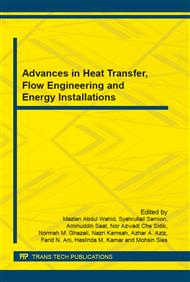[1]
Vaussard A, Martin M, Konirsch O (1986). An experimental study of drilling fluids dynamic filtration., SPE, 15412P.
DOI: 10.2118/15412-ms
Google Scholar
[2]
Tor Henry Omland (2009). Particle settling in non-Newtonian Drilling Fluids., University of Stavanger. PhD Thesis, NORWAY.
Google Scholar
[3]
Maurer Engg. Inc. (1997). Wellbore thermal simulation model: heory and User's Manual., MAURER ENGINEERING INC.
Google Scholar
[4]
Spooner KM, Bilbo D, McNeil B (2004). The application of high temperature polymer drilling fluid on Smackover operations in Mississippi., AADE-2004 Drilling Fluids Conference. Houston, Texas.
Google Scholar
[5]
Ali S (2006). Reversible drilling-fluid emulsions for improved well performance., Oilfield Review.
Google Scholar
[6]
Isehunwa S. O. and Falade G. K (2012). An approximate theory of static filtration of drilling muds in vertical wells., ARPN Journal of Engineering and Applied Sciences , Vol. 7, No. 1, January (2012).
Google Scholar
[7]
Prokop C.L. (1952). Radial filtration of Drilling Mud,. Trans, AIME. Vol. 195, Issue 5.
Google Scholar
[8]
Roland F. Krueger (1963). Evaluation of Drilling-Fluid Filter-Loss Additives under Dynamic Conditions., Journal of Petroleum Technology, Vol. 15, Issue 1.
DOI: 10.2118/431-pa
Google Scholar
[9]
Outman H. D. (1963). Mechanics of Static and Dynamic Filtration in the Borehole. Trans AIME. 228: 236.
Google Scholar
[10]
Ershaghi I. and Azari A. (1980). Modeling of filter cake build-up under dynamic -static condition,. 50th Annual California Regional Meeting of the Society of Petroleum Engineers, Los Angeles, USA, April 9-10.
Google Scholar
[11]
Fisher KA, Wakeman RJ, Chiu TW, Meuric OFJ (2000).
Google Scholar
[12]
Klotz JA and Ferguson CK, (1954). Filtration from mud during drilling., Trans AIME, 201: 29-42.
Google Scholar
[13]
Peden JM, Avalos MR, Arthur KG (1982). The analysis of the dynamic filtration and permeability impairment characteristics of inhibited water based muds., SPE Formation Damage Control Symp. Lafayette.
DOI: 10.2118/10655-ms
Google Scholar
[14]
Delhommer HJ, Walker CO (1987). Method for controlling lost circulation of drilling fluids with hydrocarbon absorbent polymer, US Patent Number, 4: 633-950.
Google Scholar
[15]
Fordham EJ, Ladva HKJ, Hall C, Baret JF, Sherwood JD (1988). Dynamic filtration of bentonite muds under different flow conditions,. 63rd Annual SPE Conference. Houston, Texas.
DOI: 10.2118/18038-ms
Google Scholar
[16]
Sherwood JD, Meeton GH, Farrow CA, Alderman NJ (1991). Concentration profile within non-uniform mud cakes., J. Chem. Soc. Far. Trans, 84(4): 611(b).
Google Scholar
[17]
Mohd. A. Kabir and Isaac K. Gamwo (2011).
Google Scholar
[18]
Saha H (2009). Pratical application of filtration theorey to the minerals industry., The University of Melbourne, Australia, PhD Thesis.
Google Scholar


